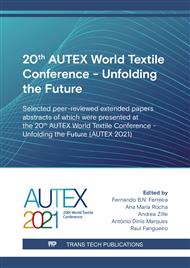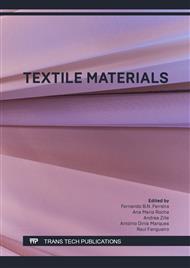[1]
J. A. Sahakian, U. S. Patent 5177996A. (1993).
Google Scholar
[2]
Y. Goldfeld, T. Quadflieg, T. Gries, and O. Rabinovitch, Smart textile reinforcement with embedded stainless steel yarns for the detection of wetting and infiltration in TRC structures, Sensors and Actuators A: Physical, vol. 243, 2016, p.139–150.
DOI: 10.1016/j.sna.2016.02.039
Google Scholar
[3]
Y. Goldfeld, O. Rabinovitch, B. Fishbain, T. Quadflieg, and T. Gries, Sensory carbon fiber based textile-reinforced concrete for smart structures, Journal of Intelligent Material Systems and Structures, vol. 27, 2016, p.469–489.
DOI: 10.1177/1045389x15571385
Google Scholar
[4]
Shuai Xu, Qian Ma, Xiao-Fang Yang, and Shu-Dong Wang, Design and fabrication of a flexible woven smart fabric based highly sensitive sensor for conductive liquid leakage detection, RSC Advances (RSC Publishing) vol. 7, (2017).
DOI: 10.1039/c7ra07273b
Google Scholar
[5]
L. M. Castano and A. B. Flatau, Smart fabric sensors and e-textile technologies: a review, Smart Mater. Struct. vol. 23, (2014).
DOI: 10.1088/0964-1726/23/5/053001
Google Scholar
[6]
T. Pereira, P. Silva, H. Carvalho, and M. Carvalho, Textile moisture sensor matrix for monitoring of disabled and bed-rest patients, IEEE EUROCON - International Conference on Computer as a Tool, Lisbon, 2011, p.1–4.
DOI: 10.1109/eurocon.2011.5929343
Google Scholar
[7]
I. Parkova, I. Ziemele, and A. Vi, Fabric Selection for Textile Moisture Sensor Design, Material Science. Textile and Clothing Technology, 2012, p.6.
Google Scholar
[8]
V. Gaubert, H. Gidik, and V. Koncar, Boxer Underwear Incorporating Textile Moisture Sensor to Prevent Nocturnal Enuresis, Sensors, vol. 20, no. 12, (2020).
DOI: 10.3390/s20123546
Google Scholar
[9]
M. Castro, B. Kumar, J. F. Feller, Z. Haddi, A. Amari, and B. Bouchikhi, Novel e-nose for the discrimination of volatile organic biomarkers with an array of carbon nanotubes (CNT) conductive polymer nanocomposites (CPC) sensors, Sensors and Actuators B: Chemical, vol. 159, 2011, p.213–219.
DOI: 10.1016/j.snb.2011.06.073
Google Scholar
[10]
M. Narkis, S. Srivastava, R. Tchoudakov, and O. Breuer, Sensors for liquids based on conductive immiscible polymer blends, Synthetic Metals, vol. 113, 2000, p.29–34.
DOI: 10.1016/s0379-6779(00)00187-9
Google Scholar
[11]
T. Villmow, S. Pegel, A. John, R. Rentenberger, and P. Pötschke, Liquid sensing: smart polymer/CNT composites, Materials Today, vol. 14, 2011, p.340–345.
DOI: 10.1016/s1369-7021(11)70164-x
Google Scholar
[12]
T. Villmow, A. John, P. Pötschke, and G. Heinrich, Polymer/carbon nanotube composites for liquid sensing: Selectivity against different solvents, Polymer, vol. 53, 2012, p.2908–2918.
DOI: 10.1016/j.polymer.2012.04.050
Google Scholar
[13]
P. A. Eutionnat-Diffo, A. Cayla, Y. Chen, J. Guan, V. Nierstrasz, and C. Campagne, Development of Flexible and Conductive Immiscible Thermoplastic/Elastomer Monofilament for Smart Textiles Applications Using 3D Printing, Polymers, vol. 12, (2020).
DOI: 10.3390/polym12102300
Google Scholar
[14]
M. Sumita, K. Sakata, S. Asai, K. Miyasaka, and H. Nakagawa, Dispersion of fillers and the electrical conductivity of polymer blends filled with carbon black,, Polymer Bulletin, vol. 25, 1991, p.265–271.
DOI: 10.1007/bf00310802
Google Scholar
[15]
M. H. Al-Saleh and U. Sundararaj, An innovative method to reduce percolation threshold of carbon black filled immiscible polymer blends, Composites Part A: Applied Science and Manufacturing, vol. 39, 2008, p.284–293.
DOI: 10.1016/j.compositesa.2007.10.010
Google Scholar
[16]
T. Villmow, B. Kretzschmar, and P. Pötschke, Influence of screw configuration, residence time, and specific mechanical energy in twin-screw extrusion of polycaprolactone/multi-walled carbon nanotube composites, Composites Science and Technology, vol. 70, 2010, p.2045–(2055).
DOI: 10.1016/j.compscitech.2010.07.021
Google Scholar
[17]
C. F. Antunes, M. van Duin, and A. V. Machado, Morphology and phase inversion of EPDM/PP blends – Effect of viscosity and elasticity, Polymer Testing, vol. 30, 2011, p.907–915.
DOI: 10.1016/j.polymertesting.2011.08.013
Google Scholar
[18]
D. Bourry and B. D. Favis, Cocontinuity and phase inversion in HDPE/PS blends: Influence of interfacial modification and elasticity, Journal of Polymer Science Part B: Polymer Physics, vol. 36, 1998, p.1889–1899.
DOI: 10.1002/(sici)1099-0488(199808)36:11<1889::aid-polb10>3.0.co;2-3
Google Scholar
[19]
L. Arboleda, A. Ares, M. J. Abad, A. Ferreira, P. Costa, and S. Lanceros-Mendez, Piezoresistive response of carbon nanotubes-polyamides composites processed by extrusion, J Polym Res, vol. 20, 2013, p.326.
DOI: 10.1007/s10965-013-0326-y
Google Scholar
[20]
X. Guan et al., Carbon Nanotubes-Adsorbed Electrospun PA66 Nanofiber Bundles with Improved Conductivity and Robust Flexibility, ACS Appl. Mater. Interfaces, vol. 8, 2016, p.14150–14159.
DOI: 10.1021/acsami.6b02888
Google Scholar
[21]
M. Javadi Toghchi et al., Electrical conductivity enhancement of hybrid PA6,6 composite containing multiwall carbon nanotube and carbon black for shielding effectiveness application in textiles, Synthetic Metals, vol. 251, 2018, p.75–84.
DOI: 10.1016/j.synthmet.2019.03.026
Google Scholar
[22]
P. A. Eutionnat-Diffo, A. Cayla, Y. Chen, J. Guan, V. Nierstrasz, and C. Campagne, Development of Flexible and Conductive Immiscible Thermoplastic/Elastomer Monofilament for Smart Textiles Applications Using 3D Printing, Polymers, vol. 12, 2020, p.2300.
DOI: 10.3390/polym12102300
Google Scholar
[23]
A. L. N. Da Silva, M. I. B. Tavares, D. P. Politano, F. M. B. Coutinho, and M. C. G. Rocha, Polymer blends based on polyolefin elastomer and polypropylene, Journal of Applied Polymer Science, vol. 66, 1997, p.2005–(2014).
DOI: 10.1002/(sici)1097-4628(19971205)66:10<2005::aid-app17>3.0.co;2-2
Google Scholar
[24]
Y. Xu et al., Reactive Compatibilization of Polylactide/Polypropylene Blends, Ind. Eng. Chem. Res., vol. 54, 2015, p.6108–6114.
DOI: 10.1021/acs.iecr.5b00882
Google Scholar
[25]
I. Taraghi, A. Fereidoon, S. Paszkiewicz, and Z. Roslaniec, Nanocomposites based on polymer blends: enhanced interfacial interactions in polycarbonate/ethylene-propylene copolymer blends with multi-walled carbon nanotubes, Composite Interfaces, vol. 25, 2018, p.275–286.
DOI: 10.1080/09276440.2018.1393253
Google Scholar
[26]
P. J. Brigandi, J. M. Cogen, and R. A. Pearson, Electrically conductive multiphase polymer blend carbon-based composites, Polymer Engineering & Science, vol. 54, 2014, p.1–16.
DOI: 10.1002/pen.23530
Google Scholar
[27]
M. Azeem, A. Boughattas, J. Wiener, and A. Havelka, Mechanism of liquid water transport in fabrics; a review, 2017, p.9.
Google Scholar



